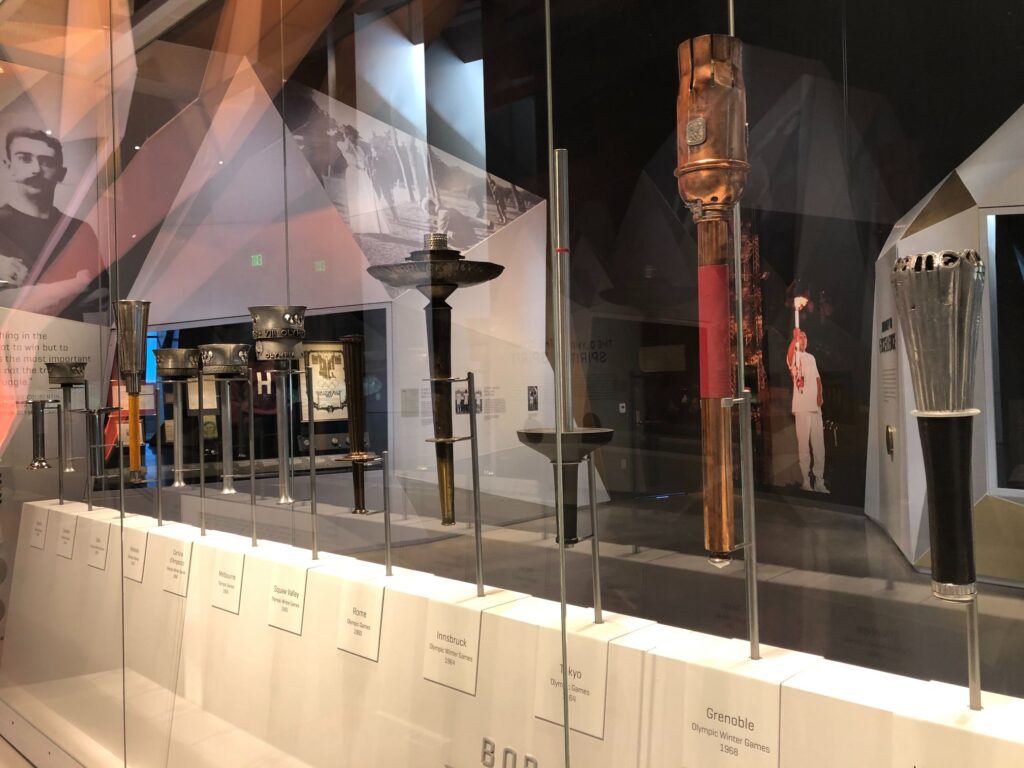
New Olympic Museum is a medal-worthy attraction

The Olympics was always a much-anticipated event for my family. We would gather together, jockeying for position in front of our small TV set, to share the excitement of competition and the pride in seeing our country’s athletes stand on the podium. We agonized when they slipped or fell, or were edged out of a medal by a nanosecond. But no matter the outcome, in our minds these talented men and women were still winners on the world’s biggest stage.
Olympians were in a class of their own and we were in awe of their accomplishments. Their stories spoke of years of sacrifice, of struggles to overcome obstacles, and of dedication and perseverance on a level we couldn’t begin to grasp. Their hopes and dreams, though, became our hopes and dreams, as we watched them represent our nation.
If you’re like me and geek out on all things Olympics, you’ll want to put the new U.S. Olympic & Paralympic Museum & Hall of Fame in Colorado Springs on your must-see list. Known as Olympic City USA, Colorado Springs is home of the U.S. Olympic Committee’s headquarters and the U.S. Olympic and Paralympic Training Center. And now with the opening of the museum, the town has achieved the Olympic trifecta.
The museum, which has already been ranked as one of the top attractions in the nation, offers a fascinating behind-the-scenes look at the Olympics and Olympians. It is a permanent tribute to the history and commitment of Team USA athletes in pursuit of Olympic and Paralympic glory.
This place, my friends, is world-class, with state-of-the-art technology and a wealth of interactive experiences. The 60,000-square foot building, which took about three years to construct, was designed by Diller Scofidio + Renfro. Located at the base of the Rocky Mountains, with views of famed Pikes Peak, it serves as an anchor for the new City for Champions District. And it will soon connect downtown Colorado Springs with the America the Beautiful Park, via a 250-foot pedestrian bridge (to be open in early 2021).
The exterior of this eye-catching building is comprised of over 9,000 folded, diamond-shaped aluminum panels, each one different and unique. The panels reflect the light and thus change in color, depending on time of day. This stunning design, with its iconic, dynamic shape, is evocative of motion and movement.
Inside, the essence of animation is continued with a spiraling form, allowing all visitors to descend the galleries in one continuous, ramped pathway. Full accessibility was a main priority during the building’s design process, resulting in the museum receiving recognition as one of the most accessible in the world.
When you arrive, you’ll register and be given a badge that interacts with the displays. This credential is enhanced with radio-frequency identification, which accommodates user preferences and aids in creating a highly personalized experience. The experience will adapt based on these selections, so for example, if you want audio descriptions, larger text or visual enhancements, those will automatically happen as you tour the museum.
The museum also uses the technology to monitor where visitors are and prevent overcrowding. Floor signage and physical dividers help promote social distancing, and face coverings are currently required upon entry. Additionally, you’ll get a complimentary stylus to navigate the exhibits and cut down on any touching.
After registration, admire “Olympus Within,” a massive bronze sculpture, created by Olympic fencer and sculptor, Peter Schifrin. Then take time to explore the Hall of Fame, the first of the museum’s twelve galleries. Members of the Hall of Fame include 119 individual Olympians and Paralympians, eleven teams, five coaches and nineteen special contributors. You can browse through the bios of such notables as Mary Lou Retton, Kristi Yamaguchi, Eric Heiden, Oscar De La Hoya, the 1996 U.S. Women’s Soccer Team, Dick Ebersol, Flo Joyner, Michael Johnson, and many more.
After learning about some of your favorite athletes, proceed to the third floor of the museum and begin working your way down through the rest of the galleries, which include: Introduction to the Games; Athlete Training; The Lab; Parade of Nations; Summer Games & Winter Games; The World Watches; Medal Collection; Theater; Medal Ceremony; and the Rotating Gallery.
Introduction to the Games provides a detailed history of the ancient Games and the origins of the modern Olympic and Paralympics. The first Olympic event was actually a 192-meter race held in 776 B.C., which was won by a cook named Koroibos. Back then, the events pitted ordinary athletes against kings and emperors.
The highlight in this gallery is the collection of Olympic torches, dating back to 1936 when the first Olympic torch relay occurred. There are also videos of torches being used to light the cauldrons at the opening ceremonies. The one of Muhammad Ali performing the task at the 1996 Games in Atlanta, while suffering tremors from Parkinson’s Disease, is especially moving.
Another interesting exhibit is the interactive map, which displays the hometowns of all 12,174 Team USA athletes, who have competed in the Olympic and Paralympic Games. The motivation behind the map is to provide a valued point of personal connection for visitors. Maybe there’s an Olympian that grew up in your city, in your neighborhood.
Athlete Training, one of the most popular galleries, offers visitors the chance to try six interactive sport demonstrations, including the 30-meter dash, alpine skiing, archery, goalball, skeleton and sled hockey. Bring your A game, as you test your speed, accuracy, focus and reaction time. Each of the activities is challenging, but I never had a chance when it came to the dash. My opponent, an animated image of Jessie Owens, finished the race before I barely got to complete one step!
Science and technology take center stage in The Lab, where you’ll learn how athletes maximize their performance in training and competition. The technological advancements in equipment, including prosthetic limbs, as well as rehab and recovery methods are remarkable. There’s also a display covering the use of performance-enhancing drugs, including a video of cyclist Tyler Hamilton talking about his personal usage, while confessing his wrongdoing.
Another highlight of the museum is the Parade of Nations. Visitors walk through a darkened tunnel before entering a 360-degree, multimedia experience that simulates the Parade of Nations during an Opening Ceremony. The excitement is palpable, as you take in this thrilling, colorful pageantry.
The Summer Games & Winter Games gallery features stories, inspirational quotes, artifacts, and autographed apparel and gear, along with interactive walls displaying in-depth information on each of the Olympic sports. Among the varied objects on display – everything from Joe Frazier’s boxing shoes (1964 Olympics in Tokyo) to Shannon Miller’s scrunchie (1996 Olympics in Atlanta) – is Paralympian John Register’s prosthetic leg. Register was an All-American hurdler when a training accident resulted in the amputation of his left leg. Six years later, he won silver in the long jump at the Sydney Paralympics.
Fans of “Miracle on Ice” will be particularly delighted to see the final scoreboard from the historic 1980 hockey game in Lake Placid between the U.S. and Russia.
The World Watches focuses on the Games’ impact on history and culture. Exhibits delve into the global political and societal influences on the Games, as well as the impacts the Games themselves have had on the world. I appreciated that the museum didn’t ignore the more serious sides of the Olympics, presenting for example, the U.S. boycott of the 1980 Moscow Games. The boycott was ordered by President Carter in reaction to the Soviet Union’s invasion of Afghanistan.
There’s also a memorial of the 1972 Munich Massacre when Palestinian terrorists took the Israeli Olympic team hostage. A video of real-time coverage of the event by Jim McKay of ABC Sports is included. I had to fight back tears as McKay announced to viewers that all of the hostages were gone.
Within this gallery is the Ask the Athlete exhibit, which uses artificial intelligence to allow visitors to converse with an Olympic or Paralympic athlete. You can ask the athletes about what drew them to the sport, their training regimen, goals, family life, etc. The technology offers a great way for visitors to “connect” with athletes.
The Rotating Gallery will change content regularly. Currently on display is artwork from LeRoy Neiman, the official Olympic painter for five Games.
Before heading into the Theater, you’ll pass through the Medal Collection. This exhibit – a nearly-complete collection of Olympic medals – is courtesy of the Crawford Family U.S. Olympic & Paralympic Archives. It’s an impressive showcase of the different styles of medals over the years, dating back to the 1896 Games in Athens.
The Theater features the film, “To Take Part,” which highlights some of the best stories of Team USA athletes. Olympians speak about their passion for the Games and their drive to compete. It’s impossible not to be inspired by these incredible individuals and their feats of excellence.
The final gallery is Medal Ceremony, where video from past Games captures some of the most poignant moments on the podium for Team USA athletes.
Connected to the museum is a gift shop and café. The Museum Shop has an ample collection of Olympic and Paralympic merchandise and trying on gear is easy with the digital mirror. The Flame Café offers pizza, gourmet salads, sandwiches and other goodies from its seasonal menu. Fuel up before channeling your inner athlete to hike or bike amid the natural splendor around Colorado Springs.























































